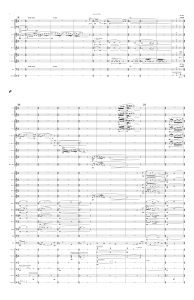THREE SHORT STORIES (2000)
for piccolo, 2 flutes 1, 2 flutes 2, 2 oboes, 2 bassoons, 2 clarinets 1, 2 clarinets 2, 2 clarinets 3, bass clarinet, 2 alto saxophones, 2 tenor saxophones, baritone saxophone, 4 trumpets, 4 horns, 4 trombones, euphonium, tuba, double bass, 8 percussion
(arranged for wind ensemble in 2012)
Doblinger Music Publishers (for PDF score and parts please write to gernot@gernotwolfgang.com)
10/19/2012 at Tennessee Tech University in Cookeville, TN by the Tennesse Tech Wind Ensemble under the direction of Joseph Hermann
Inventions, GIA Windworks CD-1004 (also features music by Bruce Broughton, Michael Daugherty, John Mackey and John Williams).
______________________________
DOWNLOAD PROGRAM NOTES (English)
Stream on Spotify
Stream on YouTube
1. Uncle Bebop
2. Rays of Light
3. Latin Dance
More information about the recording of Three Short Stories on the album INVENTIONS
______________________________
To purchase score and parts for the wind ensemble version of Three Short Stories
please contact Gernot Wolfgang
Reviews:
“It’s a rich and varied work that is probably this album’s most upbeat and memorable. There’s a theme incorporated that sounds like it could have been used as a film noir private detective score.”
Darren Rea, reviewgraveyard
“Three Short Stories is the highlight of Inventions for me. Originally written for viola and bassoon, the transformation to a full big band is amazing. These little pieces have really good bones to wear these flashy new orchestrations so lightly!”
Dean Frey, Music for Several Instruments
“Three Short Stories by Gernot Wolfgang was the most interesting piece on the program. Instead of an orchestral piece rewritten for band, this work was dramatically expanded from its original version, which is for only two instruments: clarinet and bassoon. (Wolfgang’s wife is a bassoonist.) Hearing the original version and then the one for band, there is little that surprises. The takeaway is how much music and harmony your ear fills in when it is only implied in the duet version.”
Gregory Sullivan Isaacs, TheaterJones
“Wolfgang’s Three Short Stories starts auspiciously with Uncle Bebop, a terrific piece that, if you didn’t know better, you could mistake for a jazz piece from the 1950s. The North Texas orchestra plays it with not only fine technical skill but also the right amount of swing .. The second piece, Rays of Light, is more impressionistic and less jazz-oriented, yet also reveals a fine musical mind .. With Latin Dance, Wolfgang moves into the realm of such groups as Machito and his Orchestra, the famed Afro-Cuban band of the late 1940s. The difference is that Wolfgang’s music ls less heavy on the Latin beat and more playful, with swirling clarinets and flutes.”
Lynn Rene Bayley, The Art Music Lounge
“The big band-styled “Uncle Bebop” swings with the kind of feverish energy one hears in Bernstein’s West Side Story and even ventures into rock-flavoured territory when it’s not digging into Latin-jazz swing. Dramatically contrasting in tone, the central movement, “Rays of Light,” is, formally speaking, the classical member of the triad; solo episodes abound, with various woodwind soloists granted moments to shine. Calling West Side Story even more strongly to mind, Wolfgang’s composition ends with the liveliest movement of the three, the timbales-and congas-stoked “Latin Dance.”
Textura
“Gernot Wolfgang tells three stories in music in his compelling Three Short Stories. The first is a pull out all the stops big band showstopper, appropriately titled Uncle Bebop. The second, Rays of Light musically evokes what happens when random, isolated shafts of light fall upon different things – instruments in this case, that are afforded both solo and small ensemble moments within the larger landscape of the composition. It is a moody, nocturnal, evocative piece that taps the various members of the ensemble to full advantage. Latin Dance is the composer’s third story. It is told in this context bin a full out, hip-swinging mix of salsa and Latin jazz gestures. Wolfgang’s language is essentially tonal but he does not shy away from either melody or dissonance to make his points.”
Rafael de Acha, rafaelsmusicnotes
“The opening “Uncle Bebop” has a decided Bernstein feel with excellent syncopated rhythms that explore this classic style. A more noir-ish central movement, “Rays of Light”, features a variety of solos to highlight different sections of the group and provides a great contrast. The percussion section gets to have its day in the final “Latin Dance”. Solos have a decidedly more improvisational quality as the energy is maintained throughout the movement bringing the work to an audience pleasing conclusion. This is a work that really highlights the UNT soloists very well. As a teaching piece, it introduces some important musical styles from jazz, rock, and Latin music as well as suggestions of big band music as well. The music also gradually adds a bit more dissonance as the piece comes to its conclusions with suggestions of the opening movement bringing us back to a satisfying finale.”
Steven A. Kennedy, Cinemusical
“It’s the real thing, or as real as jazz gets for a big band that’s this big.The composer, an experienced jazz arranger and performer, is speaking his native tongue.”
Andrew Anderson, TheaterJones
“Three Short Stories .. inhabit the world of Leonard Bernstein and Lalo Schifrin in a vibrant musical shindig.”
Guy Rickards, Gramophone


